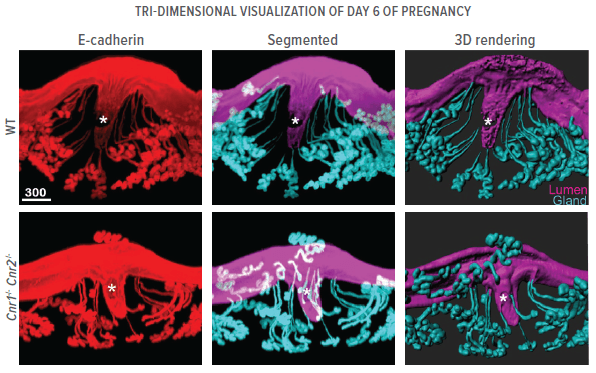Decidua Formation Depends on Proper Cannabinoid Receptor Signaling
Published September 2020 | eLife
The process of decidualization is one of the critical early stages of pregnancy. It requires a series of signaling events to support healthy embryo implantation and connection with the placenta. Now, experts at Cincinnati Children’s report new findings about the molecular processes at work in a region called the primary decidual zone (PDZ).
In mice, the PDZ encircles the implantation crypt by day 5 of pregnancy to protect the embryo from maternal immune cell attack. In previous studies, the Cincinnati Children’s Reproductive Sciences team led by Sudhansu K. Dey, PhD, has shown that excessive endocannabinoid signaling and lack of endocannabinoid signaling can disrupt the early stages of pregnancy. This study delves into how abnormal signaling can play havoc with blood vessel formation in the PDZ.
Females lacking expression of the genes Cnr1 and Cnr2 fail to receive key endocannabinoid signals that help regulate vascular remodeling. Thus, they form defective PDZs during pregnancy, which in turn compromises decidualization. The healthy process appears to require induction of CB1 membrane receptors in decidual cells (encoded by Cnr1) and CB2 receptors in endothelial cells (encoded by Cnr2). The combined role these receptors play in successful pregnancy has not been previously reported, the co-authors state.
“This investigation reveals that CB1 actions in decidual cells, combined with angiogenic activities driven by CB2, facilitate the formation of the avascular PDZ, which is critical for pregnancy success,” the co-authors state. “Taken together, our study illuminates a major responsibility for endocannabinoid signaling in modulating vascular remodeling and integrity.”
Structure of Implantation Sites
By day 6 of pregnancy, decidual responses in wild type (WT) mice promote the uterine lumen to form an arch shape, whereas in Cnr1-/-Cnr2-/- implantation sites, the lumen remains flat. These flattened structures are less likely to support a successful pregnancy.





